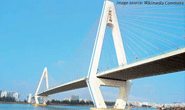India and China have drawn up massive plans for infrastructure upgradation. There are a number of areas where the neighbours can collaborate for a win-win situation.
The road is set as China has shown keen interest in participating in the development of India´s infrastructure development plan and also take India´s support in creation of its own infra assets. The newly-formed BRICS New Development Bank idea will play a crucial role in the funding of these projects. The Chinese government has hinted that the proposed Asian Infrastructure Investment Bank plan suggested by China would also support the effort. China plans to build a wide network of new silk roads on land and seas to enhance global connectivity and has invited India to be part of the project.
According to reports, the project that involves a maze of highways on land and port connectivity by sea, was expected to revive China´s trade links especially, its sagging exports, besides globally enhancing its sphere of influence. The silk road projects are slated to usher in new opportunities of cooperation between Indian and Chinese business firms as well as an opportunity to increase Chinese investments in India as it is likely to involve development infrastructure including building of roads and rail and highways, power stations and heavy equipment.
¨India and China are two of the fastest-growing economies of the world. Currently, the trade balance between the two countries is skewed in favour of China. However, both countries are focusing on development of infrastructure and have charted out massive infrastructure developments in their five-year plans,¨ according to Rakesh Dharawat, Partner, International Tax and Regulatory, KPMG in India.
As per India´s 12th Five-Year Plan, it is expected to spend $1 trillion dollars in the Indian infrastructure sector. This offers huge opportunities for China to invest in India´s infrastructure development. Recently, the Union Cabinet´s has given in-principle approval to sign an MoU for setting up industrial parks in partnership with China. India proposes to sign an MoU with China to enhance mutual co-operation across various areas of rail technology including High Speed Rail, Heavy Haulage and Station Development. ¨Given the experience China has in developing and operating high speed train corridors, it could assist in developing such corridors in India,¨ adds Dharawat.
He further suggests on how recent policies in China aim to boost West and Central regions through heavy investments in infrastructure, transport and logistics, agriculture and food processing which could present critical opportunities for Indian companies.
Earlier in the year, a Chinese working group had submitted a five-year trade and economic planning cooperation plan to the Indian government, offering to finance as much as 30 per cent of the $1 trillion targeted investment in infrastructure during the 12th Five-Year Plan (2012-17) to the tune of about $300 billion identifying key sectors such as railways, roads, telecom, and nuclear and solar power among others for investment. Sectors such as agro-processing and manufacturing have seen soaring interest from China and talks are on to set up industrial parks in India. The Department of Industrial Policy and Promotion has identified sites in Uttar Pradesh, Haryana and Andhra Pradesh where Chinese companies could set up such units. While the Indian government, under the new regime at the Centre, has shown renewed interest in reviving the infrastructure segment, generating finances still remains a daunting task. The slowdown experienced by the sector has made the private sector wary of investing in infrastructure projects. Whereas according to a Deloitte report, in China, local governments have been one of the major drivers behind China´s infrastructure. State-owned commercial banks and policy banks hold around 80 per cent of total infrastructure loan portfolios, and bank financing accounts for more than 50 per cent of total infrastructure financing. China has been successful in attracting foreign investment by providing improved infrastructure and a favourable regulatory environment. Corporate bonds have become more important, but remain a small share in total financing as the bond market remains underdeveloped. China has many infrastructure SPVs listed in the stock market.
According to a KPMG-IMC report, China´s infrastructure spending is 31.3 times larger than India´s infrastructure investment. Looking ahead, if the proposed partnership is able to concretize post scrutiny and formation of suitable policies, India´s infra development plan will definitely move on the fast track.
<strong>Ranking on quality of Infrastructure</strong><br />
<table style="font-size:13px; border:solid 1px #CCCCCC;" width="400" border="0" cellspacing="0" cellpadding="0">
<tr>
<th align="left" valign="middle" style="padding:5px; border:solid 1px #CCCCCC; border-left:none; border-top:none;">Indicator</th>
<th width="61" align="center" valign="top" style="padding:5px; border:solid 1px #CCCCCC; border-left:none; border-top:none;">China</th>
<th width="66" align="center" valign="top" style="padding:5px; border:solid 1px #CCCCCC; border-left:none; border-top:none;">India</th>
</tr>
<tr>
<td width="71" align="left" valign="top" style="padding:5px; border:solid 1px #CCCCCC; border-left:none; border-top:none;">Quality of overall infrastructure</td>
<td align="center" valign="top" style="padding:5px; border:solid 1px #CCCCCC; border-left:none; border-top:none;">69</td>
<td align="center" valign="top" style="padding:5px; border:solid 1px #CCCCCC; border-left:none; border-top:none;">87</td>
</tr>
<tr>
<td align="left" valign="top" style="padding:5px; border:solid 1px #CCCCCC; border-left:none; border-top:none;">Quality of roads</td>
<td align="center" valign="top" style="padding:5px; border:solid 1px #CCCCCC; border-left:none; border-top:none;">54</td>
<td align="center" valign="top" style="padding:5px; border:solid 1px #CCCCCC; border-left:none; border-top:none;">86</td>
</tr>
<tr>
<td align="left" valign="top" style="padding:5px; border:solid 1px #CCCCCC; border-left:none; border-top:none;">Quality of railroad infrastructure</td>
<td align="center" valign="top" style="padding:5px; border:solid 1px #CCCCCC; border-left:none; border-top:none;">22</td>
<td align="center" valign="top" style="padding:5px; border:solid 1px #CCCCCC; border-left:none; border-top:none;">27</td>
</tr>
<tr>
<td align="left" valign="top" style="padding:5px; border:solid 1px #CCCCCC; border-left:none; border-top:none;">Quality of port infrastructure</td>
<td align="center" valign="top" style="padding:5px; border:solid 1px #CCCCCC; border-left:none; border-top:none;">59</td>
<td align="center" valign="top" style="padding:5px; border:solid 1px #CCCCCC; border-left:none; border-top:none;">80</td>
</tr>
<tr>
<td align="left" valign="top" style="padding:5px; border:solid 1px #CCCCCC; border-left:none; border-top:none;">Quality of air transport infrastructure</td>
<td align="center" valign="top" style="padding:5px; border:solid 1px #CCCCCC; border-left:none; border-top:none;">70</td>
<td align="center" valign="top" style="padding:5px; border:solid 1px #CCCCCC; border-left:none; border-top:none;">68</td>
</tr>
<tr>
<td align="left" valign="top" style="padding:5px; border:solid 1px #CCCCCC; border-left:none; border-top:none;">Quality of electricity supply</td>
<td align="center" valign="top" style="padding:5px; border:solid 1px #CCCCCC; border-left:none; border-top:none;">59</td>
<td align="center" valign="top" style="padding:5px; border:solid 1px #CCCCCC; border-left:none; border-top:none;">110</td>
</tr>
<tr>
<td colspan="3" align="left" valign="top" style="padding:5px; border:solid 1px #CCCCCC; border-left:none; border-top:none;">Source: Global Competitiveness Report 2012-13, World Economic Forum<br />
Note: Ranking out of 144 countries</td>
</tr>
</table>
– Garima Pant



Leave a Reply
You must be logged in to post a comment.